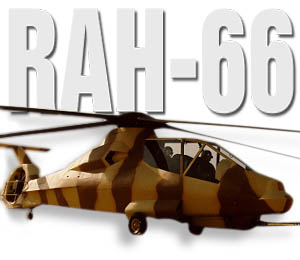

The U.S. Army's new aviation modernization plan has as its centerpiece
the Boeing-Sikorsky RAH-66 Comanche armed reconnaissance helicopter. The aviation plan
reflects the Army's new post-Cold war strategy to react to regional conflicts by using
fewer personnel and long-range, self-deployable aircraft based in the continental United
States.
The Comanche is a twin-turbine, two-seat (tandem) armed reconnaissance helicopter with
projected missions of armed reconnaissance, light attack and air combat. Initial operating
capability is set for the year 2003.
Outstanding features of the Comanche's systems and features include its five-bladed
bearing-less main rotor; FANTAIL anti-torque system; low observables (radar, infrared and
acoustic); on-board diagnostic system; triple redundant fly-by-wire flight-control system;
and fully retractable missile armament system.
Team Comanche is led by Boeing and United Technologies' Sikorsky Aircraft Division.
The Boeing-Sikorsky team, chosen in 1991 to develop the RAH-66 Comanche reconnaissance
attack helicopter for the U.S. Army, continues its design and test program in
Philadelphia.
Powerplant:
Two T800-LHTEC-801 turboshaft engines.
Rotor system:
Five-bladed, bearingless main rotor.
FANTAIL anti-torque. Facts:
Self-healing digital mission electronics.
Longbow fire-control radar.
Passive long-range, high-resolution sensors.
Triple-redundant fly-by-wire flight control system.
wide-field-of-view helmet-mounted display.
Simple remove-and-replace maintenance system. Milestones:
April 1991: Dem/val prototype (contract go-ahead).
January 1992: Preliminary design review.
November 2004: Initial production Crew:
Low-work crew station--2.